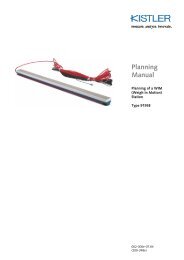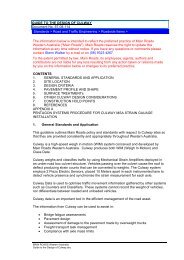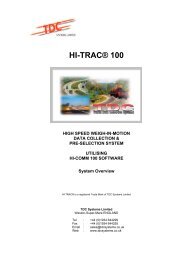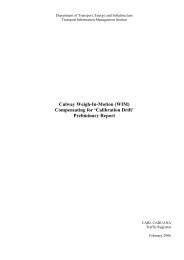AP-G84/04 Best practice in road use data collection, analysis ... - WIM
AP-G84/04 Best practice in road use data collection, analysis ... - WIM
AP-G84/04 Best practice in road use data collection, analysis ... - WIM
You also want an ePaper? Increase the reach of your titles
YUMPU automatically turns print PDFs into web optimized ePapers that Google loves.
Accessed by AR - ARRB TRANSPORT RESEARCH on <strong>04</strong> Feb 2005<br />
Aust<strong>road</strong>s 20<strong>04</strong><br />
— 41 —<br />
<strong>Best</strong> Practices <strong>in</strong> Road Use Data Collection, Analysis and Report<strong>in</strong>g<br />
hours of the counter be<strong>in</strong>g <strong>in</strong>stalled <strong>in</strong> the field. This allows Transit to undertake <strong>in</strong>dependent<br />
visual surveys at random to ensure the contractor is perform<strong>in</strong>g as expected and provid<strong>in</strong>g<br />
quality <strong>data</strong>. Any variation between recorded <strong>data</strong> and the visual surveys of ± 5% will result <strong>in</strong><br />
the contractor hav<strong>in</strong>g to repeat the survey at their cost.<br />
(b) Cross-checks - The contractors responsible for the Short-term Stations are asked to<br />
undertake random (once very three years) classified counts at each of the permanent<br />
telemetry sites as a way of <strong>in</strong>dependently validat<strong>in</strong>g the accuracy of each other’s equipment<br />
and <strong>data</strong> collected. Any variance of ± 5% is then the source of <strong>in</strong>vestigation to assess why<br />
the results are different. As both parties are <strong>in</strong>dependent, the contractors have a strong<br />
<strong>in</strong>centive to ensure their methodology and equipment accurately record traffic at these sites.<br />
In summary, the count<strong>in</strong>g personnel whether contractors or <strong>in</strong>-ho<strong>use</strong> staff should be well prepared<br />
<strong>in</strong> terms of count<strong>in</strong>g equipment, suitable seats, appropriate cloth<strong>in</strong>g <strong>in</strong>clud<strong>in</strong>g cont<strong>in</strong>gency<br />
provisions for adverse weather, amenities (food, toilet), and carry authority certificates.<br />
Conspicuous signage is not recommended as it may affect count results.<br />
6.3 Quality Check and Deal<strong>in</strong>g with Miss<strong>in</strong>g Data<br />
The pr<strong>in</strong>ciple of edit<strong>in</strong>g <strong>data</strong> and identify<strong>in</strong>g miss<strong>in</strong>g <strong>data</strong> is endorsed as a good <strong>practice</strong> at the<br />
October 2003 Road Use Data Workshop. The Department of Infrastructure, Energy and<br />
Resources <strong>in</strong> Tasmania recommended the need to describe clearly how the edit<strong>in</strong>g is carried out.<br />
This may <strong>in</strong>volve the <strong>use</strong> of meta<strong>data</strong> to provide traceability (meta<strong>data</strong> is ‘<strong>data</strong> on <strong>data</strong>’ <strong>use</strong>d to<br />
describe the content, condition and other characteristics <strong>in</strong> the <strong>data</strong>). In US, Smith et al. (2003)<br />
endorsed a similar pr<strong>in</strong>ciple and suggested the need to reconsider the AASHTO (1992) policy of<br />
not estimat<strong>in</strong>g miss<strong>in</strong>g (or ‘imput<strong>in</strong>g’) <strong>data</strong>.<br />
Each RA has its own <strong>data</strong> quality check<strong>in</strong>g procedures, which are also different for different <strong>data</strong><br />
types. It is beyond the scope of this report to record all procedures; however, few examples of<br />
current <strong>practice</strong>s from Queensland Ma<strong>in</strong> Roads, RTA NSW, Ma<strong>in</strong> Roads WA and the CSIRO<br />
software developed for RTA, are presented below for illustration.<br />
The current Queensland Ma<strong>in</strong> Roads <strong>practice</strong> is to ensure complete <strong>data</strong> sets at Pattern Stations<br />
dur<strong>in</strong>g annual process<strong>in</strong>g. Miss<strong>in</strong>g <strong>data</strong> are computed at the hourly level us<strong>in</strong>g weekly and hourly<br />
adjustment factors, i.e.<br />
Miss<strong>in</strong>g hour volume = Anticipated AADT × Week factor × Hour factor<br />
RTA NSW pays special attention to classified counts and the <strong>data</strong> rejection rules for classified<br />
counts at RTA NSW are shown <strong>in</strong> Table 17.

















